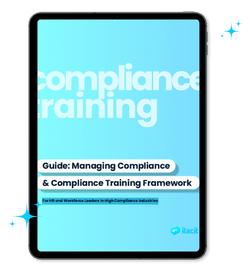Employee communication in today’s workplace is increasingly complex. Teams are spread across various roles, locations, and work environments, including remote, in-person, and hybrid arrangements. On top of that, generational differences between younger employees and seasoned veterans add another layer of complexity.
While delivering clear messages is a key part of internal communications, it’s also crucial to develop a comms and business strategy that keeps everyone engaged and informed, regardless of their location.
Frontline employees, who often work in dynamic and fast-paced roles outside traditional office settings, face unique communication challenges. They require timely updates and clear, actionable information to perform their tasks effectively. A well-designed communication strategy addresses these needs, ensuring all employees, especially those on the front lines, stay connected and informed.
In times of crisis, a strong employee communication plan becomes even more important. It makes sure that essential updates reach every employee, helping to maintain focus and calm under pressure.
An employee communication strategy that considers the needs of all workers, particularly those in frontline roles, will build a resilient and cohesive team that’s ready to tackle any challenge.
Ready to learn more about employee communication strategies? Let’s explore some best practices and actionable tips to enhance communication across your organization.
The foundation for the strongest employee communications strategy
To help you navigate the challenges in developing an effective employee communication strategy, we’ve identified five strategic pillars that can shape your employee internal communication efforts in 2025 and beyond.
These pillars aren’t rigid rules but flexible best practices that can adapt to your organization’s unique needs.
Whether you’re focused on aligning communication with your business goals, crafting personalized messages, or preparing for unexpected situations, these steps will provide a strong foundation for keeping your frontline employees in the loop and motivated.
These strategic pillars can help you create an internal comms strategy that truly connects with all team members.
Pillar 1: Aligning communication with organizational objectives
Linking communication to business goals
A communication strategy is most effective when it’s directly tied to your company’s objectives. For frontline employees, who may not always be tuned into broader corporate messaging, this alignment is crucial. It helps them see how their roles contribute to the organization’s overall success, making their work feel more meaningful and connected to the bigger picture.
Your internal communications goals will vary depending on your industry, company size, and the maturity of your existing strategy. Whether you’re aiming to boost employee engagement, improve information flow, or enhance collaboration, it’s important to tailor your communication efforts to support these specific business objectives.
Prioritizing employee needs and expectations
Each employee has unique needs that must be addressed to keep them engaged and effective. Understanding and incorporating these needs into your communication strategy helps boost productivity and morale across your team. Employee satisfaction surveys often reveal that clear and frequent communication is a key driver of job satisfaction and performance. That means that employee communication has a direct impact on organizational objectives.

Pillar 2: Segmenting and personalizing communication
Identifying and segmenting target audiences
Different roles and locations require tailored communication strategies. Segmenting your audience ensures that each group receives information relevant to their specific context, whether they’re on the shop floor, in the field, or working remotely. Personalized communication helps prevent information overload and enhances message relevance.
With a frontline employee communication app, you can easily tailor communication to the individual or to groups based criteria like roles or location, making sure that the right people get the information they need.
Pillar 3: Choosing and integrating communication channels
Using a multi-channel approach
Frontline employees rely on mobile devices for communication. Using a variety of channels such as a mobile application, text messaging, phone and video calls, company intranet, a monthly newsletter, and internal social media, ensures that your messages are accessible to everyone, no matter where they are.
Maintaining consistency across channels
Consistent messaging across all platforms helps avoid confusion and builds trust. This ensures that important information is communicated clearly and is easily understood, regardless of the channel used.
Pillar 4: Building a feedback-driven communication culture
Establishing continuous feedback mechanisms
Frontline workers are often the first to notice potential issues or areas for improvement. Regular feedback loops allow you to refine your communication strategy and address concerns before they escalate.
Adapting strategy based on feedback and data
Listening to feedback from your employees—and acting on it—helps you create a more responsive and inclusive communication strategy. Use data and insights from your communication tools to continuously improve how you connect with your team.
Pillar 5: Implementing crisis communication for frontline employees
Preparing for the unexpected
In a crisis, quick and clear communication is crucial. A well-structured crisis communication plan is the best way to make sure that all employees receive timely updates.
Communicating transparently to reduce panic
Your employees need clear, trustworthy information when a crisis strikes. Transparent and consistent updates help prevent confusion and keep your team focused and calm. Using secure, accessible channels, you can provide the guidance they need to navigate difficult situations.
Why is an employee communication strategy so important?
Your employee communication strategy is the backbone of any successful organization, especially when it comes to remote, frontline, and dispersed workers. This strategy will guide teams to create a consistent, engaging, and trustworthy flow of communication that aligns with your business goals across the entire organization.
For frontline workers, who might not have regular access to traditional communication channels like email or in-person meetings, a tailored strategy ensures they stay informed, feel valued, and are empowered to do their best work. In times of crisis, a strong internal communication plan can be the difference between chaos and calm, providing clear, actionable information that helps your team navigate challenges with confidence.

Internal vs. external communication strategies
Internal and external communication strategies, though interconnected, serve distinct purposes.
Internal communication focuses on building employee engagement and alignment within the organization. It involves sharing vital information, aligning employees with company goals, and building a cohesive work environment.
External communication, on the other hand, deals with interactions outside the organization, including managing public relations, marketing efforts, and customer relations.
Effective internal communication is crucial for maintaining employee morale, productivity, and employee engagement. In contrast, external communication aims to build a positive image and manage stakeholder relationships.
The role of senior leaders, management, and department heads within the employee communication strategy
An effective internal communication strategy isn’t just the responsibility of the communications team. It requires active participation and leadership from senior leaders, management, and department heads. Their involvement is crucial in setting the tone, building trust, and ensuring that communication flows effectively throughout the organization.
Leading by example
Senior executives, senior leaders, human resource managers, and department heads play a key role in demonstrating the importance of communication. When leaders are transparent, open, and consistent in their messaging, it sets a standard for the rest of the organization. Employees are more likely to engage with and trust communications when they see their leaders doing the same.
Empowering middle management
Middle managers are often the link between senior leadership and frontline employees. They play a critical role in interpreting and disseminating information in a way that resonates with their teams.
Equipping middle managers with the right tools, training, and support, helps make sure that they can effectively convey messages, gather feedback, and address any concerns that arise.
Encouraging two-way communication
For internal communication to be effective, it must be a two-way street. Senior leaders and department heads should not only share information but also actively listen to employee feedback. This open communication feeds into a culture of transparency and inclusiveness, making employees feel valued and heard.
Encouraging dialogue between the management team and staff can lead to higher satisfaction and improved morale, making for a better employee experience overall. A Gallup study found that employees are 2.8 times likelier to be engaged when they regularly talk to their manager about their goals and successes.

Aligning communication with company culture
For internal communication to hit the mark, it needs to resonate with the company’s culture and values. Leaders are key elements to make sure that every message—whether it’s a quick update or a major announcement—reflects the organization’s mission and values.
When communication is in sync with these core principles, it strengthens the company’s identity and helps employees feel more connected to the broader goals of the business. This consistency is crucial for reinforcing company culture and boosting employee loyalty.
To make this happen, leaders should collaborate with their communication teams to weave the company’s culture into all internal messaging. Here are a few ways to do that:
- Brand books: Create detailed guides that outline the company’s mission, values, and expected behaviors. These serve as a go-to resource, ensuring everyone is on the same page about what the company stands for.
- Information sessions: Hold regular sessions to discuss the company’s values and how they should be reflected in daily work. These sessions can help clarify expectations and underline the importance of cultural alignment.
- Training programs: Make cultural alignment a key part of training and onboarding programs so that new hires are immersed in the company culture from the start.
- Team-building activities: Plan activities that encourage teamwork and embody the company’s values in a more relaxed setting, helping employees internalize these principles.
- Workshops and keynotes: Organize workshops and keynote speeches, led by company leaders or guest speakers, that focus on the significance of culture and how it drives success.
- All-hands meetings: Use all-hands or town hall meetings to reiterate the company’s mission and values, and share success stories that highlight how these are being lived out in real life.
These actions and collaboration tools help ensure that the company’s culture is actively lived and felt throughout the organization. This approach creates a more connected and motivated workforce that’s aligned with the company’s goals and ready to contribute to its success.
Implementing effective communication strategies for 2025
These five strategic pillars offer a flexible and practical approach to creating a communication strategy that truly resonates with your frontline employees.
Whether you’re aiming to align communication with your business objectives, personalize messages, or prepare your crisis management plan, these guidelines will help you keep your workforce connected, informed, and engaged—no matter what challenges come your way.
FAQ
How can I ensure that my frontline employees receive important messages?
To make sure your frontline employees get important messages, use a multi-channel approach that includes mobile app messaging, text messaging, and push notifications. These channels are more accessible for employees who may not have regular access to email or a computer. Tailor your messaging to their specific needs and roles to keep them engaged and informed.
What should I include in a crisis communication plan for frontline workers?
A crisis communication plan for frontline workers should include clear protocols for who communicates what, how information will be disseminated, and which channels will be used. Make sure the plan is mobile-friendly and easy to access, so all employees can stay updated, regardless of their location or work environment.
How do you measure the effectiveness of employee communication strategies?
Measure the effectiveness of your communication strategy by tracking key performance indicators (KPIs) like click-through rates, message open rates and other email metrics, employee feedback, and engagement levels.
Regularly review this data to identify what’s working and where there’s room for improvement. Using tools that offer analytics and feedback mechanisms can help you refine your approach over time.










